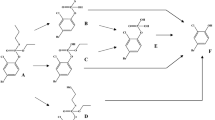Abstract
THE insecticide ‘Isolan’ (1-isopropyl-3-methyl-5-pyrazolyl dimethylcarbamate) is more toxic to rats by the dermal than by the oral route1. This finding is interesting, because the opposite is true of most compounds. It was not known whether the unexpected difference in the toxicity of ‘Isolan’ by the two routes was caused by detoxification in the intestinal lumen, poor absorption from the gastrointestinal tract, detoxification in the liver, unusually efficient percutaneous absorption, or some other mechanism.
Similar content being viewed by others
References
Gaines, T. B., Toxicol. App. Pharmacol., 2, 88 (1960).
Ross, P. L. E., and Rappaport, A. M., Nature, 188, 326 (1960).
Bollman, J. L., J. Lab. Clin. Med., 33, 1348 (1948).
Tullner, W. W., and Hertz, R., Endocrinology, 66, 494 (1960).
Author information
Authors and Affiliations
Rights and permissions
About this article
Cite this article
GAINES, T., HAYES, W. & LINDER, R. Liver Metabolism of Anticholinesterase Compounds in Live Rats : Relation to Toxicity. Nature 209, 88–89 (1966). https://doi.org/10.1038/209088a0
Issue Date:
DOI: https://doi.org/10.1038/209088a0
- Springer Nature Limited
This article is cited by
-
Metrifonate
Archives of Toxicology (1978)
-
Metabolic fate of dichlorvos in swine
Archiv f�r Toxikologie (1972)





